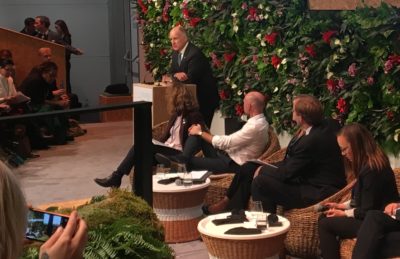What do U.S. states do at a COP, anyway?
Newsom’s out, but California and other states continue with robust delegations headed to Scotland

You’ve likely heard that the big annual United Nations climate conference is about to get underway in Glasgow, with nations around the world gathering together to try to advance international climate cooperation. But it’s not just national representatives who will attend; many subnational jurisdictions, including California and other U.S. states, also send significant delegations. Although Gov. Newsom just abruptly announced that he’s cancelled his travel plans, our state and others will be on the ground in Scotland in force. So it’s worth asking: What do they do there?
The question is particularly appropriate because, formally, states don’t have a seat at the table in U.N. negotiations. The core of this gathering is the yearly “conference of parties” (or COP) of the UN Framework Convention on Climate Change and its related implementing protocols, including the Kyoto Protocol and, most recently, the Paris Agreement. Under international law, only countries can be parties to these instruments, not U.S. states or other subnational goverments. So in one sense, California is situated with respect to these talks just like other observers: It’s an outsider looking in, trying to influence the talks where it can, but without any formal power to do so. This is true (and likely a little frustrating) notwithstanding that California’s economy is bigger than that of all but 4 or 5 nations.
California has a few reasons to show up anyway. The first is boosterism–which isn’t as silly as it may sound. California has a story to tell about its pioneering efforts to address climate change, including through some groundbreaking mitigation programs that were first developed here and later exported to other jurisdictions. COPs are a good place to tell that story. They include, alongside the formal negotations, a host of side events, informal gatherings, information booths, evening meetings, and high- and low-level interactions of every sort, taking advantage of the fact that they gather together many of the world’s leading climate experts, stakeholders, policymakers, and advocates. You might think of them as the world’s most existentially frightening trade show.
People at COPs are interested in California’s story. At one COP, I found myself walking alongside a group of party delegates speaking a language I didn’t understand and soon realized that I did recognize one phrase they kept repeating: “AB 32”. That is, of course, the name of the law, passed in 2006, that set California’s first economy-wide GHG reduction mandate. It’s not an exaggeration to say that the world watches what we do on climate in California, and COPs provide a direct way for California to share its experiences with new audiences.
Second, and relatedly, California and other subnational jurisdictions want partners in their work. Subnationals, no matter how large and powerful, can’t solve the climate change problem alone, and they know it. When subnationals show up to COPs, they can use these events to gin up interest in cooperative climate networks; they can learn from each other about what’s working and what isn’t; and they can push each other to do more. This isn’t merely theoretical; the Under 2 Coalition was created, as I understand it, after a series of meetings between subnationals leading up to and around COPs and was launched at the Paris COP in 2015. (My fellow blogger Ken Alex knows much more about this story than I do, having been a key figure in the creation of the U2C–I’m sure he could say more.) That network of subnationals cooperating on climate change now includes areas accounting for 50% of global GDP.
These reasons partly explain why, for example, the Climate Registry and Climate Action Reserve are helping to bring “the largest subnational delegation ever” to this COP. In the U.S., states and local jurisdictions provide some of the strongest, most consistent, and most persuasive voices for climate progress. With federal action having taken pendulum swings across recent Presidential administrations, many state leaders have been stalwart advocates for mitigation and adaptation. They are often left to deal with climate effects on the ground, from wildfires to sea level rise to drought, and they can provide a political bulwark of sorts even as U.S. federal climate action wavers or underdelivers. That may prove very useful at COP26 and beyond.
Reader Comments
One Reply to “What do U.S. states do at a COP, anyway?”
Comments are closed.








Thanks for sharing this informative post with us.